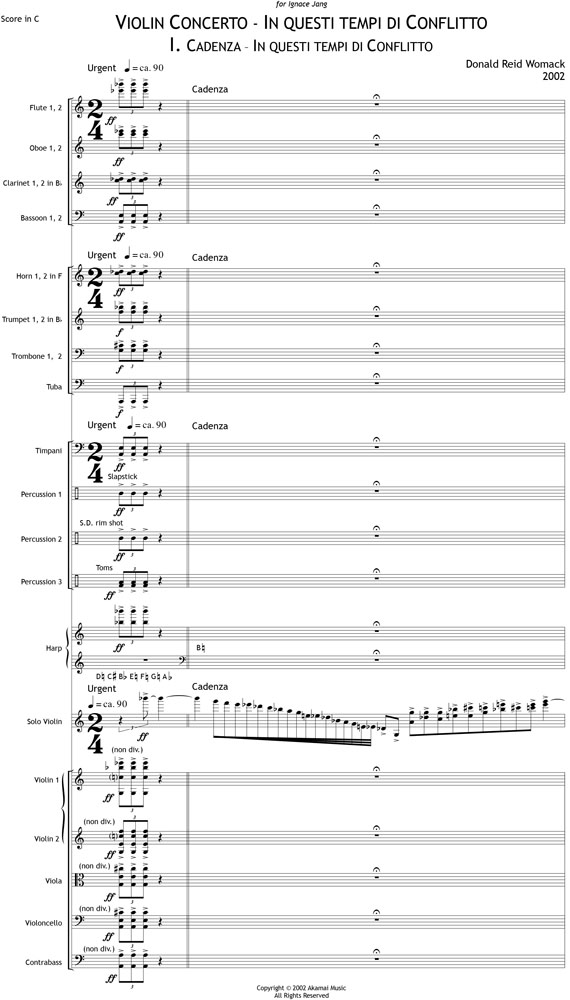Violin Concerto
In questi tempi di Conflitto
Price range: $35.00 through $700.00
violin & orchestra
(2222 2221 timp 3 prc hp strings)
- In questi tempi di Conflitto
- In questi tempi di Dolore
- In questi tempi di Cambiamento
37:00
2003
As I began work on my violin concerto in early Fall of 2001, the world was newly immersed in an atmosphere of tension and uncertainty. The events which ensued from that time have affected most of the world’s population, forcing each of us to face emotions and possibilities we would ordinarily not experience. Fear, anger, love, hatred, frustration, confusion, and, above all, sorrow have been the dominant themes of our current existence, to which we each must respond in our own manner.
As an artist, my response comes through my work, and as I composed the violin concerto I found it necessary to develop these emotional themes. Reflecting this collective experience, the piece is about conflict, grief, and hope. It has no specific programmatic references, but instead presents the experience of the times in a general emotional sense.
These concepts — conflict, grief, and hope — form the basis of the three movements. Conflict is the order of the day, that of which we are continually aware. Grief, not only for lives lost – and yet to be lost – but also for an innocence which has been permanently scarred, is perhaps the most powerful consequence of this age. Finally, conflict necessarily leads to change, while hope is the element needed to make this change positive. These three ideas create an emotional progression which mirrors the musical progression of the piece.
The first movement, Cadenza — In questi tempi di Conflitto (Cadenza — In these Times of Conflict), presents a picture of unease and instability. The movement opens with an extensive and tense solo cadenza which presents the basic material for the entire piece. The thematic ideas presented here will be developed throughout all three movements, creating a sense of metamorphosis as the same ideas reappear with transformed (or sometimes static) characters in evolving contexts. The notion of conflict is played out through the interaction between soloist and orchestra, as well as through the nature of the thematic material. Following the opening cadenza, the music passes between orchestra and soloist, with the two sometimes in conflict and sometimes in accord. Numerous brief cadenzas appear and contribute to the air of instability, as the music’s character and tempo continually change. The first theme, with its swirling chromatic descent, depicts the chaos of the movement, while other passages have elements of raw violence, aggression, struggle, and uncertainty. Moments of beauty and even joy appear abruptly, though they are short-lived. Near the end of the movement the opening cadenza returns, now accompanied by orchestra. The conflict is left unresolved, as the high point of tension leads directly to the second movement.
This middle movement, Canto — In questi tempi di Dolore (Song — In these Times of Sorrow), depicts a sense of grief and pain. Its lyrical themes hint at a pervasive sadness which can be neither overlooked nor overcome. At the same time, it suggests the resolve necessary in order to move past the present conflict. The lyricism of the solo lines continually dissolves into anger or despair, as beauty and violence alternate, with neither gaining supremacy. As the music floats upward at movement’s end we are left knowing that, although we may learn to accept and eventually even embrace it, this grief will forever remain with us.
The final movement, Coda — In questi tempi di Cambiamento (Coda — In these Times of Change), represents hope. It is a non-stop rush of activity, a moto perpetuo which takes the basic motives of the first two movements and puts them in a virtuosic context. The ideas of conflict and hope are juxtaposed throughout the movement. The violent, destructive opening gradually evolves into a more positive mode, only to be dragged back down into violence. The struggle between these two ideas as well as between soloist and orchestra continues throughout the movement until the hope for positive change eventually assumes control. Finally, an exultant coda ends the piece with a virtuosic flurry, an energetic and optimistic view that, although struggle is inevitable, such conflict can, indeed, lead to a positive outcome.

